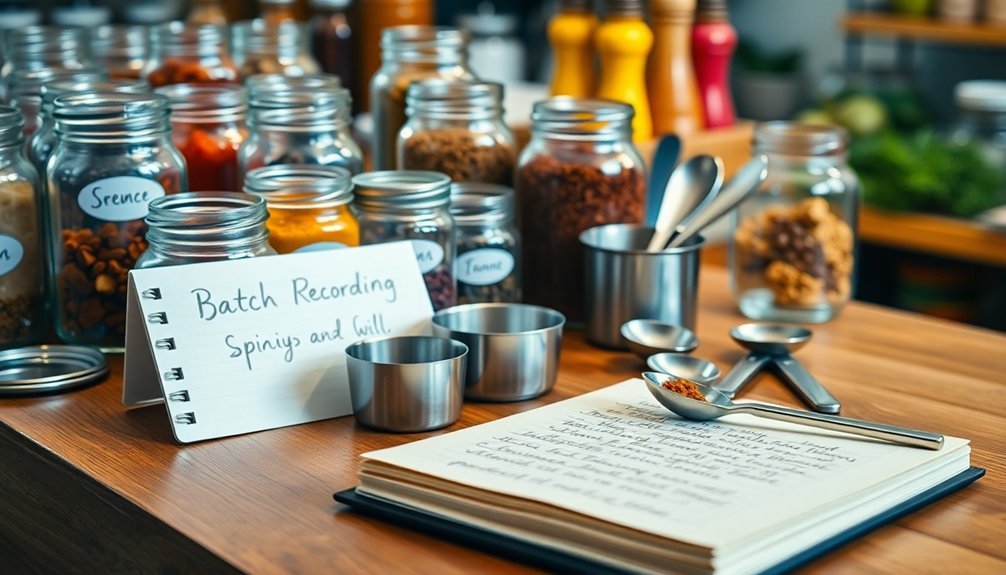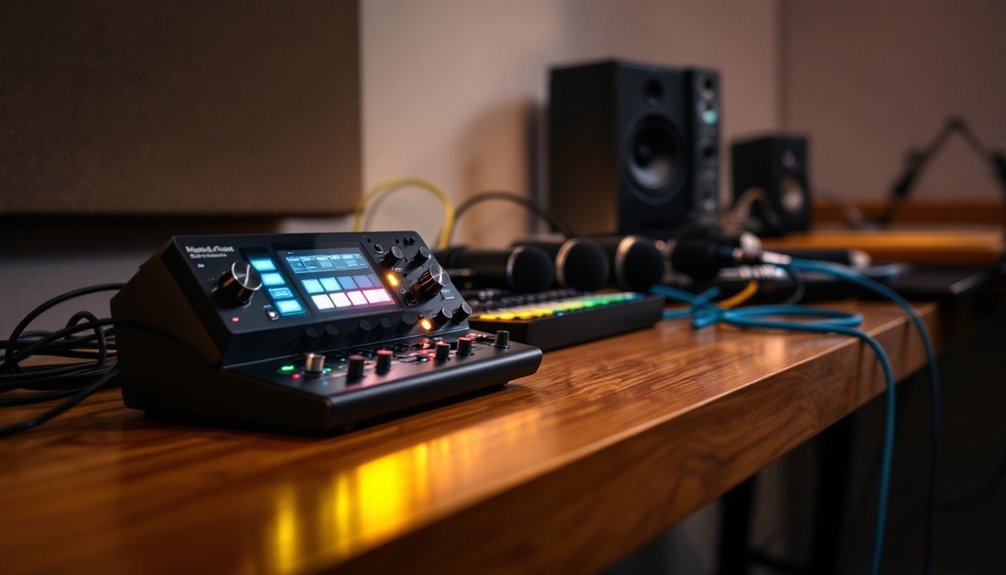Professional batch recording for soap making requires just five simple steps: establish a unique batch numbering system, document all ingredient details precisely, record production processes in real-time, note any deviations with corrective actions, and implement verification through sign-offs. You'll need to organize recipes by type, maintain detailed ingredient records, create clear documentation templates, and establish quality control checkpoints throughout your process. These fundamentals will transform your soap making from hobby to professional operation.
5 Simple Steps For Professional Batch Recording

Five key elements form the foundation of professional batch recording.
First, establish a unique batch numbering system that combines letters and numbers for easy identification and traceability.
Second, document all ingredient details including name, quantity, supplier, and lot number as you add them to your formulation.
Third, record your production process in real-time using clear, concise language that anyone could follow. Don't wait until later when details might be forgotten. This approach ensures quality consistency across different batches and helps maintain product standards.
Fourth, note any deviations from standard procedures immediately, along with corrective actions taken.
Finally, implement a verification system where everyone involved signs off on the completed batch record.
Setting Up Your Soap Recipe Documentation System
A professional soap recipe documentation system builds on the batch recording fundamentals we just covered.
You'll need an extensive structure that organizes your soap recipes by type while ensuring easy retrieval and consistent quality. Start by establishing a unique coding system for each recipe and batch, allowing you to track variations and historical changes.
- Implement specialized software like SoapMaker to manage ingredients, calculate lye amounts, and maintain your recipe database.
- Create detailed master formulas with precise measurements, quality control checkpoints, and scalability options.
- Develop a standardized batch numbering system that links directly to recipe codes.
- Establish digital backup procedures to prevent data loss and maintain real-time documentation.
With this system in place, you'll transform scattered recipes into a professional library that supports efficient production and consistent quality. The SoapMaker Software enables you to thoroughly document each new batch by recording lot numbers for ingredient traceability.
Organizing Essential Ingredients and Equipment Records

Meticulous ingredient and equipment documentation forms the backbone of professional batch recording, ensuring your soap production remains consistent and traceable.
Record each ingredient's name, source, lot number, and exact quantity in both percentage and actual weight.
Even when you've slightly deviated from your master formula, document the actual amounts used. This precision enables quality control and simplified troubleshooting if issues arise.
Don't forget to list all equipment and tools utilized in your batch. Note specific mixing containers, thermometers, and other implements that affect your final product's quality.
Maintain thorough supplier information including purchase dates and lot numbers. This creates a complete chain of accountability and makes potential product recalls manageable.
When deviations or defects occur, document them along with your corrective actions.
Assigning a unique batch number to each production run ensures proper identification throughout the manufacturing process and distribution chain.
Creating Detailed Process Documentation Templates
Developing thorough documentation templates streamlines your entire soap-making process while ensuring nothing gets overlooked.
You'll save time with each new batch when you've established a consistent format that captures all critical information. Create customizable templates in familiar tools like Word or Excel that include sections for process descriptions, inputs, and expected outputs.
Your templates should include:
- Clear visual elements like diagrams or flowcharts showing the production sequence
- Designated spaces for recording both raw materials and equipment used
- Specific fields for documenting each step with timestamps
- Areas to note quality checkpoints throughout the process
Review your templates periodically and refine them based on user feedback, keeping all stakeholders informed of updates through your version control system. Make sure your documentation is easy to edit for future updates as your process evolves.
Implementing Quality Control Checkpoints

Because consistent quality is crucial for professional soap production, you'll need to establish strategic checkpoints throughout your manufacturing process. Your batch records should include verification points where you'll confirm compliance with standards before proceeding to the next step.
| Checkpoint | Action Required |
|---|---|
| Raw Materials | Verify ingredients match specifications and lot numbers |
| Equipment Setup | Confirm calibration status and cleanliness documentation |
| Critical Process Steps | Document temperature, timing, and visual assessments |
| Final Product | Test pH, weight, fragrance intensity, and appearance |
| Packaging | Inspect labels, batch codes, and packaging integrity |
Train your team to recognize when measurements fall outside acceptable parameters and document all corrective actions taken. It's essential to inspect approval signatures in your batch records to maintain accountability and ensure proper authorization throughout the production process. Implement a review system where a second person validates critical calculations and signatures. This dual-verification approach greatly reduces errors and guarantees your products consistently meet quality standards.
Frequently Asked Questions
How Do I Recover Corrupted Batch Recording Files?
To recover corrupted batch recording files, you'll want to immediately stop using the storage media, create a backup, and try recovery tools like Wondershare Repairit, CHKDSK, or professional recovery services for critical data.
Can Batch Recording Processes Work Across Different Operating Systems?
Yes, batch recording processes can work across different operating systems. You'll need cross-platform compatible software that leverages APIs and centralized scheduling. Many modern batch frameworks support multi-system operations for seamless workflow integration.
What's the Optimal File Format for Long-Term Batch Record Storage?
For long-term batch record storage, you'll want to use PDF/A as your primary format. It's self-contained, platform-independent, and designed specifically for archiving with built-in security features and metadata support.
How Much Cpu/Ram Should I Allocate for Simultaneous Batch Processes?
Allocate 1-2 CPU cores and 2-4GB RAM per batch process, scaling with complexity. You'll need to analyze historical performance, monitor utilization, and adjust based on your specific workload patterns for maximum efficiency.
Are Cloud-Based Batch Recording Solutions More Reliable Than Local Software?
Cloud-based solutions offer better reliability through automatic updates and backups, but you'll need consistent internet. Local software gives you more control and offline capabilities. Your choice depends on your specific reliability priorities.
In Summary
You've mastered the art of batch recording for your soap making business. By documenting your recipes, organizing your inventory, creating detailed templates, and implementing quality checkpoints, you'll guarantee consistency across all productions. Remember, proper documentation isn't just about record-keeping—it's about building a professional foundation that assures quality products and customer satisfaction while making your scaling journey much smoother.





Leave a Reply